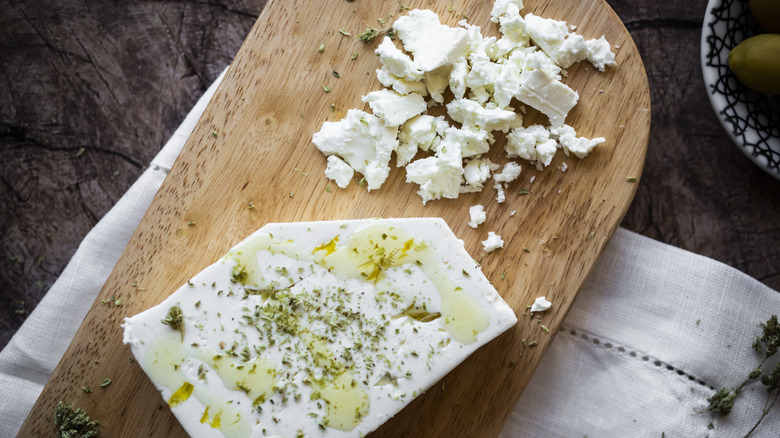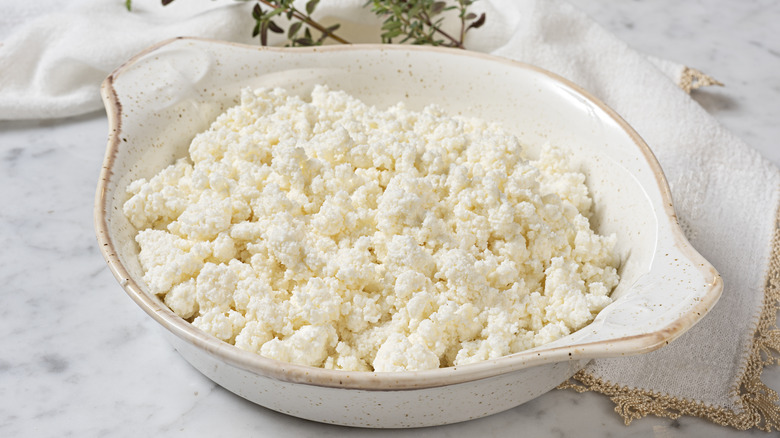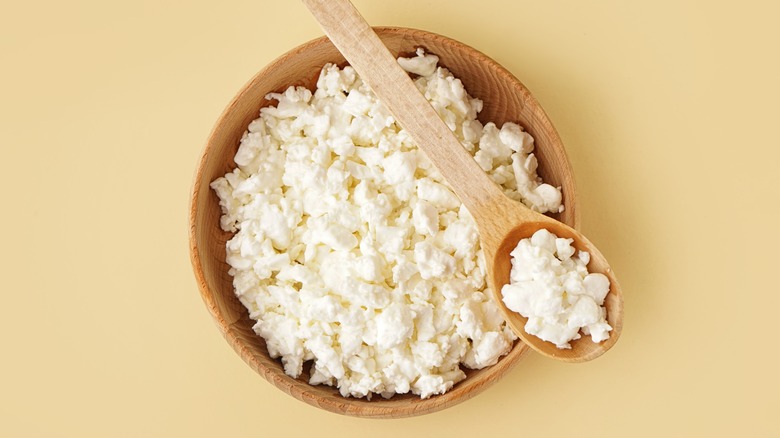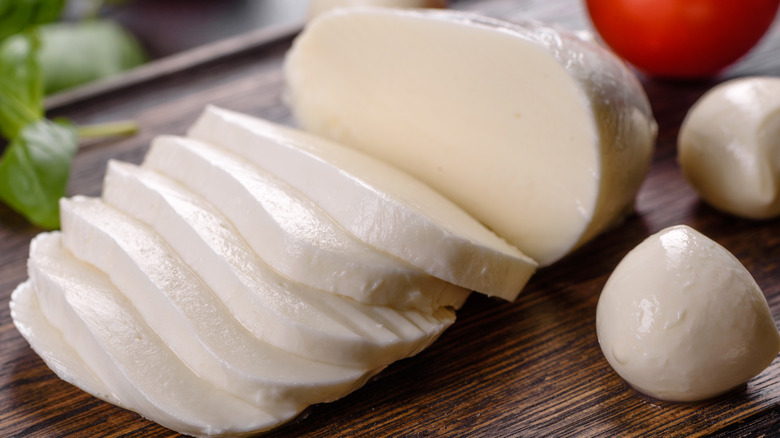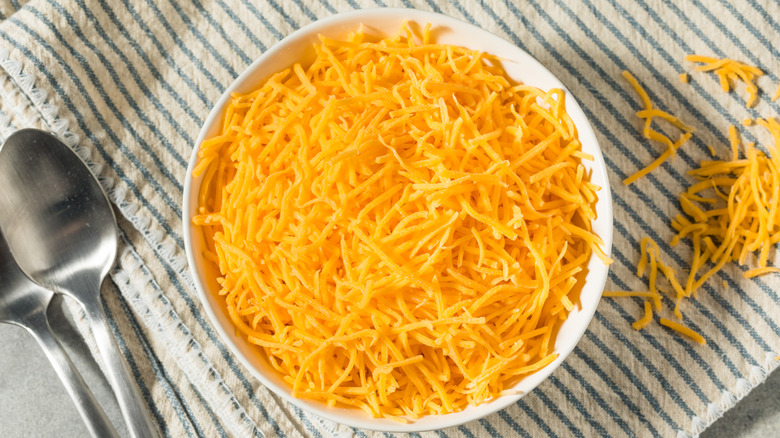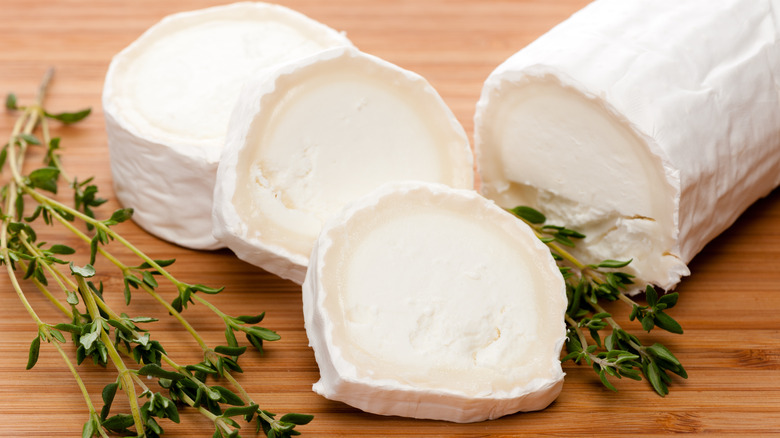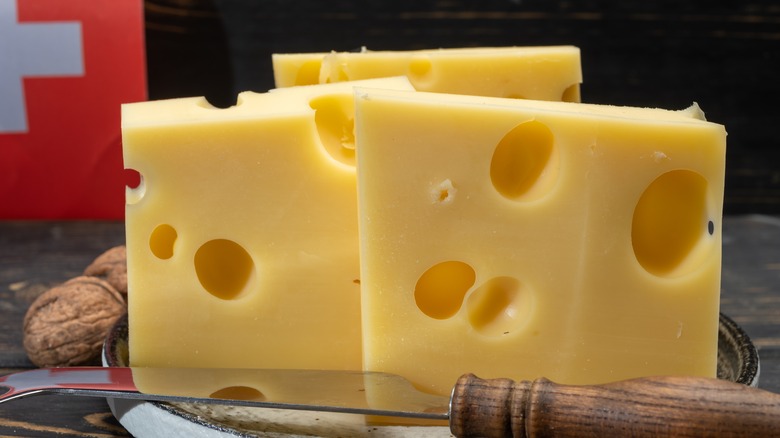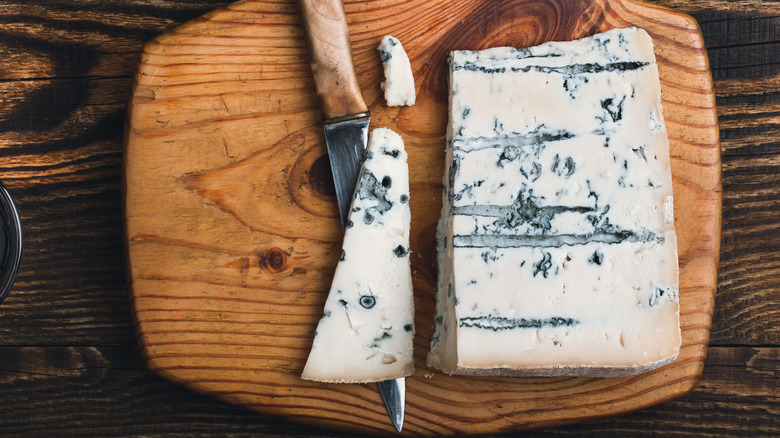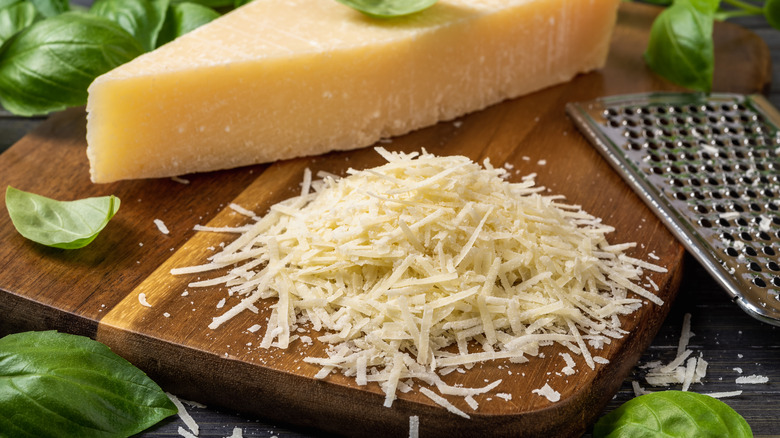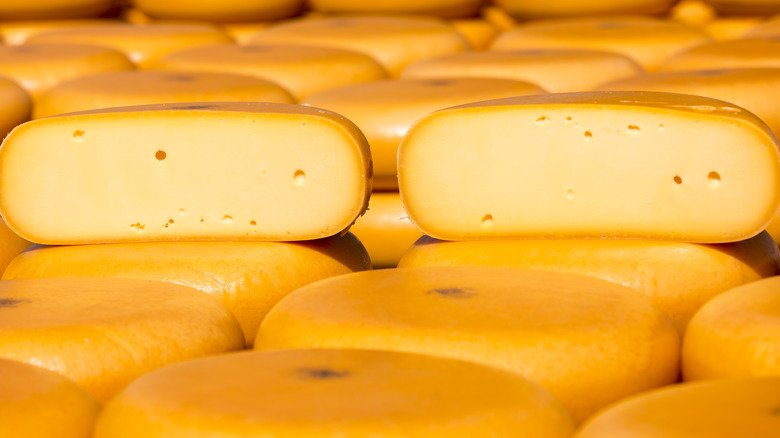The Healthiest Cheeses You Can Eat (And Surprising Benefits Of Each)
Whether it started as an accident tracing back to around 1000 BCE or as a means to preserve the milk extracted from newly domesticated animals (via Encyclopedia Britannica), cheese has become a beloved dietary staple for people around the globe for millennia. Through a complex fermentation process involving bacteria, rennet, and salt, milk can transform into countless variations, which are so popular that the American Cheese Society (ACS) even holds numerous yearly programs and competitions to celebrate it, boasting numerous diverse categories that classify cheeses according to milk type, chemical composition, aging characteristics, sensory properties, specific cheese styles, and varieties, to mention a few.
Nevertheless, while cheese's place in human history can't be denied, its healthfulness is often challenged. On the one hand, cheese is rich in nutrients like calcium and protein while also packing a range of vitamins and health-promoting compounds, such as conjugated linoleic acid (CLA), an omega-6 fatty acid that may support heart health (per Healthline). In addition, some types of cheese, especially those that are aged and unpasteurized, can also offer probiotics, promoting a healthy gut microbiome (via Harvard Health Publishing). On the other hand, cheese can also have a high saturated fat and sodium content, depending on the variety. Ultimately, many varieties boast surprising advantages, making them a nutritious option when included mindfully in the diet. Keep reading to discover which cheeses should make it past your shopping cart and into your table on your next cheese run.
Feta cheese
Few foods scream "Greece" more than feta cheese, seeing that, according to a study published in Foods, this Greek staple is the most consumed cheese in the country. In fact, cheese is a protected designation of origin (PDO) food, meaning that it must be produced in specific areas within the country to earn the name. The flavorful cheese is traditionally made from sheep's milk or a combination of sheep and up to 30% goat's milk. Its production involves curdling the milk with lactic acid and rennet, draining the whey, and cutting the curd, after which the curds are salted and stored in a brine solution. This process gives feta its crumbly texture and distinctively tangy, salty flavor (via Healthline).
Regarding feta's health benefits, the cheese is known for boasting a lower fat content compared to some aged cheeses, most of which are comprised of CLA, which may help reduce your risk of obesity and diabetes while providing additional cancer-fighting properties. Moreover, its nutritional profile, namely its calcium, protein, phosphorus, and probiotic content, may benefit your bone and gut health. Despite its benefits, feta has some potential downsides, notably its high sodium content due to the brining process. In fact, the study found that this cheese might be responsible for the elevated salt intake among Greeks, which surpasses the World Health Organization's (WHO) recommended limit of five grams per day. Still, feta cheese is a highly versatile food that can be used for dishes ranging from salads and sandwiches to entreés and desserts thanks to its bold flavor, which pairs nicely with fresh and hearty ingredients.
Ricotta cheese
Soft and creamy, ricotta is coveted for its fluffy yet spreadable texture and mildly sweet flavor, a combination of organoleptic characteristics that turn the cheese into the ideal ingredient for both savory and sweet dishes, such as dips, lasagna, stuffed pasta, cheesecake, and pastries (via Cheese.com). While ricotta is widely recognized as a type of cheese, the site explains that, technically, it isn't. In fact, it is made from the leftover whey from other cheeses, typically from cow, sheep, buffalo, or goat's milk. Its production involves recooking the whey and straining it through a cheesecloth to gather the newly formed and smaller, softer curds (via Encyclopedia Britannica). The process's recooking part leads to the cheese's name, seeing that ricotta is the Italian word for recooked.
Nutritionally speaking, ricotta is a rich source of protein and calcium, with half a cup providing a whopping 10 grams of the macronutrient and over 20% of the mineral's daily value (DV), per the USDA Food Data Central. Additionally, the Encyclopedia Britannica explains that this cheese has another nutritional advantage over other spreadable cheeses, like cream cheese or mascarpone, by providing a significantly lower fat content. On that note, a review published in The Journal of Dairy Science shares that ricotta cheese delivers monounsaturated and polyunsaturated fatty acids, the healthy kind that helps with heart health. However, keep in mind that since ricotta cheese is made from leftover whey, which consists of lactose and water, it may be an unsuitable choice for people with lactose intolerance.
Cottage cheese
Favored among health enthusiasts and popular for its versatility in the kitchen, cottage cheese is a fresh cheese made from cow's milk. This cheese is characterized by its soft yet lumpy texture, courtesy of its distinctive curds, and you may easily find it in different fat content levels, ranging from full-fat to low-fat and fat-free versions. Among its many health-promoting attributes, cottage cheese is especially popular for its high protein yet low-calorie content. For example, a one-cup serving of low-fat cottage cheese boasts 24 grams of protein while only providing 180 calories (via the USDA Food Data Central), and did we mention the same serving has a mere five grams of fat? No wonder both athletes and dietitians swear by this cheese.
Due to its nutritional profile, cottage cheese is often the go-to choice in weight loss diets, especially the low-fat varieties, seeing that its high protein content helps prolong feelings of fullness, which helps keep your appetite in check (per the Cleveland Clinic). In addition, the site explains that its protein content also comes in handy when trying to pack some muscle, mainly due to the effects of casein on muscle synthesis and recovery. Plus, like most other cheeses, it also boosts your bone health. On the downside, cottage cheese might not be well tolerated by people with lactose intolerance, who might experience bloating and abdominal pain due to its high lactose content (per Healthline). If you're thinking about adding cottage cheese to your diet, try it on its own over toast or crackers, mixed with fruits, or added to savory dishes like salads and scrambled eggs.
Mozzarella cheese
Commonly known for its distinct round or sphere-like shape and mild flavor, mozzarella cheese is an Italian fresh cheese originally made from buffalo's milk. However, cow's milk varieties are also available in the market. What probably distinguishes this cheese from other types of fresh cheeses is its processing method. After curdling the milk, cheesemakers perform a technique called pasta filata (which roughly translates to stretched curd) in which they mix the curd with hot whey and then stretch it and knead it until it becomes soft and elastic (per Cheese Origin). This ensures the cheese gets its uniquely soft and springy texture and rounded shape.
Regarding its nutritional properties and health benefits, mozzarella cheese is a good source of vitamin B12, with a single ounce of cheese providing 30% of the nutrient's DV (via the USDA Food Data Central). Vitamin B12 is essential for DNA and red blood cell formation, as well as for keeping a healthy nervous system. Since the vitamin is naturally available only through animal-based foods, mozzarella cheese is an especially important food item for those following vegetarian diets. Culinarily speaking, mozzarella cheese is deeply engrained in Italian cuisine, as its melting capacity has made it an indispensable ingredient for pizzas, lasagnas, and baked pasta dishes. Yet, you may also find it in cold dishes like salads and paninis, namely the famous Caprese salad.
Cheddar cheese
Shrap in flavor and bold in color, cheddar is an English gift to the world of cheese. The cheese is produced with cow's milk, and it follows a unique processing method called "cheddaring," which involves having the firm curd cut, stacked, and pressed to remove moisture. Then, the cheese is left to age anywhere from three months to two years, granting it its bold flavor, which heightens with age. While many associate cheddar cheese with not-so-healthy dishes like nachos, it may surprise you that its nutritional profile might grant it cholesterol-lowering properties, namely due to its protein and calcium composition (per WebMD).
Moreover, according to a study published in The Journal of Dairy Science, cheddar cheese might be a good source of beta-carotene, the pigment responsible for the cheese's color, which also has antioxidant and anti-inflammatory properties (via the Cleveland Clinic). Plus, cheddar cheese provides significant amounts of CLA, ranging from 0.15 to 0.44 grams per 100 grams of cheese, depending on the feeding system used to feed the cows. For reference, CLA has a recommended daily intake of between 0.8 and 3.2 grams. Whether you prefer it shredded, cubed, sliced, melted, or in a solid block, you could say that cheddar's versatility in the kitchen is unmatched. From mac and cheese to charcuterie boards, grilled cheese sandwiches, and casseroles, its bold flavor will surely be the star of your meal.
Goat cheese
Goat cheese, or chevre, is a healthy and typically creamy and spreadable cheese. Yet, it can be turned into a firm and crumbly one when aged. Either way, goat cheese is perfect for those who have trouble tolerating cheeses made from cow's milk, seeing that it has a naturally lower lactose and casein concentration, meaning that people with lactose or casein intolerance won't struggle as much to digest it (via Healthline). In addition, the site explains that goat cheese contains medium-chain fatty acids (MCFAs), a healthy type of fat that, according to a study published in the Journal of Functional Foods, has multiple health-promoting benefits, including aiding weight loss by increasing satiety and energy expenditure, boosting heart health by preventing atherosclerosis, enhancing blood sugar control by improving insulin resistance, counteracting memory impairment in people with Alzheimer's Disease, and even providing anti-cancer properties, as well as anti-convulsant effects for people with epilepsy.
When it comes to cooking with goat cheese, its texture and flavor make it a tasty addition to breakfast dishes like omelets or toast. You can also find it in main courses and side dishes as part of salads, roasted veggies, pizzas, or pasta dishes, and even in desserts paired with fruit and honey. In short, goat cheese's healthfulness and deliciousness can easily become a part of your diet in both gourmet and everyday meals.
Swiss cheese
Known for its iconic holes, also known as eyes, Swiss cheese is a pale yellow hard cheese made from cow's milk with a sweet but nutty flavor. However, according to Cheese.com, the larger the eyes, the bolder the flavor. The cheese's famous holes are formed during its manufacturing process. Unlike other cheeses, after the milk curds are formed and drained, they're mixed with lactic acid-producing bacteria and left to age and ferment. This fermentation is the part of the process that leads to the formation of the characteristic holes. Nutritionally speaking, Swiss cheese is an excellent source of protein, vitamin B12, and calcium, with a single slice providing 28% and 25% of the DV for the vitamin and mineral, respectively (via the USDA Food Data Central), supporting bone health and DNA metabolism.
Swiss cheese also contains lower sodium levels compared to many other cheeses, making it a heart-friendly option when consumed in moderation (via Healthline). Plus, per WebMD, evidence suggests that it contains compounds with blood pressure-lowering properties, meaning that its heart-healthy effects might be even broader (again, when consumed in moderate amounts). Yet, keep in mind that it still boasts a high saturated fat content, which is something to consider if you're keeping an eye on your cholesterol levels. Regarding its culinary uses, Swiss cheese is highly versatile. Due to its unparalleled melting capacity, the cheese is a staple in grilled cheese sandwiches and fondues or casseroles. It also shines on charcuterie boards, as it pairs nicely with deli meats like prosciutto, fruits, and nuts.
Blue cheese
While mold in food usually signals that an item is past its prime, this is certainly not the case for blue cheese, as this specific type of mold is not toxic. Blue cheese gets its distinctive blue or green moldy streaks by adding Penicillium roqueforti mold mixed with milk during the cheese-making process, resulting in a cheese with a sharp and salty flavor (via Medical News Today). The cheese, which can be made with cow's, goat's, or sheep's milk, is a good source of calcium and phosphorus, with a one-cup serving of crumbled blue cheese packing 55% and 42% of the DV of each (per the USDA Food Data Central). This makes it a beneficial food item for bone and teeth health. Additionally, blue cheese also contains vitamin K, which, according to a review published in Mini-Reviews in Medicinal Chemistry, plays a role in bone metabolism and blood coagulation.
Despite its nutritional benefits, blue cheese has its own disadvantages. For instance, while blue cheese's mold is non-toxic, it can produce toxic compounds once the cheese begins to spoil, leading to symptoms that might range from mild and short-lived to severe and long-lasting. Regarding its culinary applications, blue cheese adds a contrasting flavor to dishes ranging from salads to burgers. It also pairs well with fruits like pears, figs, apples, nuts, and honey, which is why it often finds its way into charcuterie boards.
Parmesan cheese
Parmesan cheese is an Italian golden and hard yet brittle cheese that's aged for long periods of time, granting it its distinctive umami flavor. Like most cheeses, parmesan cheese is a good source of protein. However, according to an article published in Food Technology and Biotechnology, proteins in parmesan not only provide all essential amino acids, but they're also relatively easy to digest thanks to the cheese's long aging process. The article explains that during ripening, proteins in parmesan get hydrolyzed or broken down into smaller particles, a process that would be similar to pre-digestion, making it easier for the body to assimilate.
Plus, the cheese's fat composition provides it with healthy fatty acids, including CLA and MCFAs. Lastly, it also explains that parmesan is a virtually lactose-free cheese, making it an ideal option for people with lactose intolerance. Being the quintessential Italian ingredient, parmesan cheese is commonly grated over Italian classics like pasta or soup. You might also enjoy it shaved over salads, carpaccios, and pizzas. Whether used as a finishing touch or a primary ingredient, parmesan cheese will surely enhance the flavor of numerous dishes.
Gouda cheese
Named after the town of Gouda in Holland, this cow's milk cheese is available in a broad range of textures and flavors, all of which depend upon the length of its aging process (via Nutrition Advance). For instance, gouda cheese that has been aged for merely a month tends to be softer and milder in flavor. In contrast, when aged for over a year, the cheese develops a bolder taste, and its texture becomes more firm. Nevertheless, all gouda varieties have in common that they're produced using unpasteurized milk, meaning that the friendly bacteria (probiotics) present in the milk still remain in the end product. Probiotics help improve gut health by balancing the bacterial environment in your gut, which plays a key role in metabolism and overall health (per Harvard Health Publishing).
However, gouda's fat content can be high, which might pose concerns for those managing their fat intake, and it is not a good option for those following a lactose-free diet. Once again, when it comes to cooking with gouda, its uses vary depending on the type of gouda you choose. Softer varieties melt smoothly and are perfect for casseroles and other baked or grilled dishes. On the other hand, aged gouda works best in cheese boards or salads.


